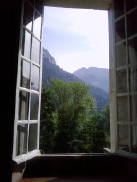If you were listening, the season brought the usual surge of Christmas music through all manner of electromagnetic transmission, wired and wireless, causing me to remember again my mild preoccupation with one tune in particular, namely – Do You Hear What I Hear? For the past few years I found myself listening more closely […]
|
|||||
|
Another article about physics and mathematics by Natalie Wolchover, published in both Wired and Quanta Magazine, got my attention because it began like this: In late August, paleontologists reported finding the fossil of a flattened turtle shell that “was possibly trodden on” by a dinosaur, whose footprints spanned the rock layer directly above. The […] Quanta Magazine recently published an interview with physicist and author Lee Smolin. Smolin talked about his most recent book, Einstein’s Unfinished Revolution: The Search for What Lies Beyond the Quantum, and the influence that Gottfried Leibniz, has had on the perspective that Smolin most recently adopted. Seventeenth century polymath, Gottfried Wilhelm Leibniz, known for […] A special September issue of Scientific American is organized around questions about what we seem to know, and how or why we may be deceived about the nature of reality. This special September issue has the title: Truth Lies and Uncertainty. No doubt the editors are inspired, to some extent, by the challenges to […] The Closer to Truth team recently did a series of interviews addressing the following question: Do persons have souls? Interviewees included philosopher and cognitive scientist Daniel Dennett; author, medical doctor and holistic healer, Deepak Chopra; philosopher Eleonore Stump; Warren Brown, Director of the Edward Travis Research Institute at the Fuller Theological Seminary and Professor […] Recently, I had the opportunity, to listen to Vered Rom-Kedar give a public lecture entitled Billiard is not just a game. Until now, I haven’t thought much about this expanding branch of mathematics but, for me, the lecture highlighted some of the reasons I find mathematics so captivating, and it encouraged me to keep […] My attention was recently brought to a discussion of grid cells and spatial imagery as they relate to cognitive strengths in dyslexic individuals. The discussion takes place in the book The Dyslexic Advantage by Drs. Brock and Fernette Eide, and it amplified many of the thoughts I have expressed about the biological aspect of […] Physics theoretician Nima Arkani-Hamed, at the Institute for Advanced Study at Princeton, has recently suggested that maybe space and time are not what we think they are. In a recent interview with Natalie Wolchover, for a New Yorker article, he expressed renewed interest in a point made by Richard Feynman in 1964. [1] Feynman […] In my last post I tried to argue that Humberto Maturana’s biology of language might have something to say about the biological nature of mathematics. This biology of language that Maturana proposes is understood in the context of autopoiesis (the continuous self-creation of any living system) that is his fundamental definition of life. I […] I have long been interested in the notion of autopoiesis introduced by Humberto Maturana and Francisco Varela in 1972. In short, autopoiesis is the model of living systems that sees every living system (from single cells to multicellular organisms) as individual unities whose living is the creation of themselves. Through the interaction of their […] |
|||||
|
Copyright © 2025 Mathematics Rising - All Rights Reserved Powered by WordPress & Atahualpa |
|||||


Recent Comments